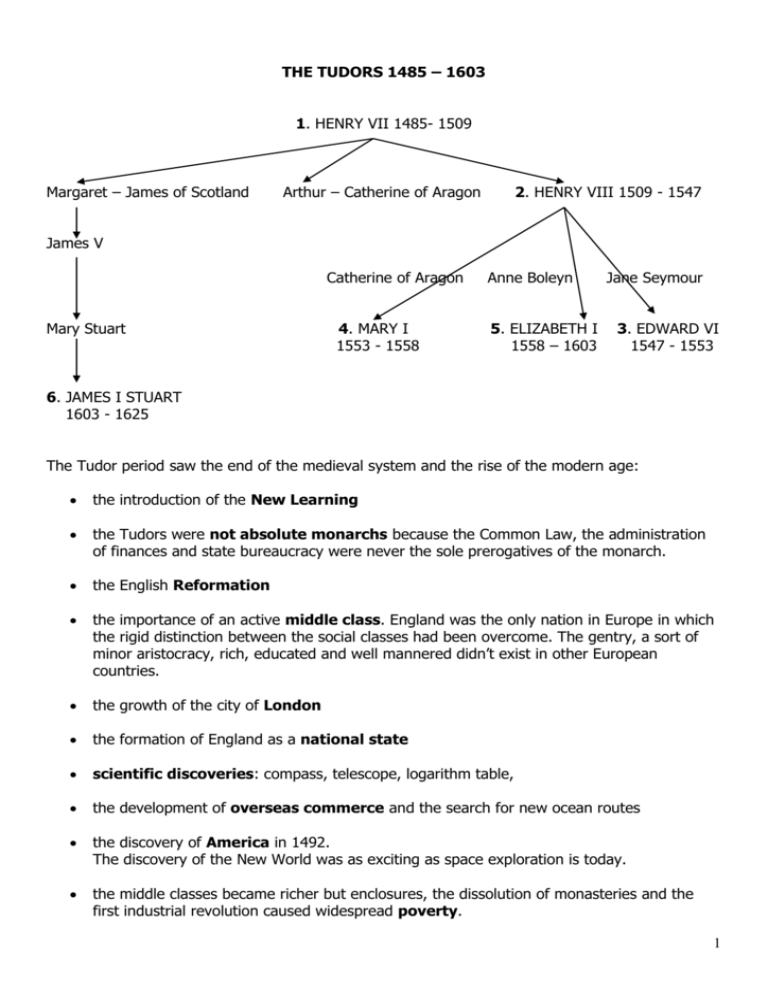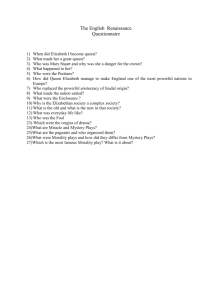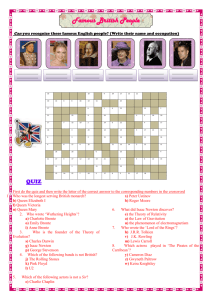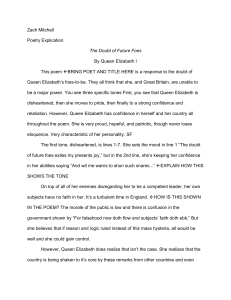The Renaissance
advertisement

THE TUDORS 1485 – 1603 1. HENRY VII 1485- 1509 Margaret – James of Scotland Arthur – Catherine of Aragon 2. HENRY VIII 1509 - 1547 James V Catherine of Aragon Mary Stuart 4. MARY I 1553 - 1558 Anne Boleyn 5. ELIZABETH I 1558 – 1603 Jane Seymour 3. EDWARD VI 1547 - 1553 6. JAMES I STUART 1603 - 1625 The Tudor period saw the end of the medieval system and the rise of the modern age: the introduction of the New Learning the Tudors were not absolute monarchs because the Common Law, the administration of finances and state bureaucracy were never the sole prerogatives of the monarch. the English Reformation the importance of an active middle class. England was the only nation in Europe in which the rigid distinction between the social classes had been overcome. The gentry, a sort of minor aristocracy, rich, educated and well mannered didn’t exist in other European countries. the growth of the city of London the formation of England as a national state scientific discoveries: compass, telescope, logarithm table, the development of overseas commerce and the search for new ocean routes the discovery of America in 1492. The discovery of the New World was as exciting as space exploration is today. the middle classes became richer but enclosures, the dissolution of monasteries and the first industrial revolution caused widespread poverty. 1 HENRY VII 1485 - 1509 He had no right, he had conquered the throne. The country was in a state of chaos and the economy was extremely weak. He was diplomatic, cruel, suspicious, despotic. He was skilled in politics and economics. he was very rich: he confiscated the lands of the nobles who had lost the War of the Roses. He was an able business man and accountant. He left his son 3 billion pounds. he had the monopoly of artillery. he built a powerful mercantile fleet. he didn’t spend money at war, he favoured a policy of peace: he married Arthur to Catherine of Aragon, daughter of the king of Spain and Margaret to the king of Scotland he didn’t call a Parliament because he didn’t need money and ruled as an absolute monarch the barons and the nobles were limited: - they could no longer maintain private soldiers. Armies could only be raised by the king. - He forbade to build castles. The only castles are the king’s ones. the new merchant class and the landowners obtained more participation in government affairs. The council of the king was formed by less nobles and the upper middle classes over which he had absolute control. He favoured merchants and lawyers who owed everything to the king, were educated and loyal. The merchants and the gentry had grown in importance through enclosures and had bought monastic estates. 2 HENRY VIII 1509 - 1547 When he succeeded his father he was only 18. He was a typical Renaissance king: he maintained a magnificent court. He was a scholar, a musician, a hunter, an archer and a wrestler, interested in honour and fame. Financial crisis was due to the fact that he attacked France but failed and this cost him a lot of money. France and Spain were very powerful and England had to keep the balance between them. Moreover gold and silver from America caused inflation. There was crisis in commerce and widespread misery. He built a fighting fleet of modern vessels: slender and long with cannons. He married his widowed sister-in-law Catherine of Aragon: they had 5 children but only one daughter survived. In order to marry Ann Boleyn, who was pregnant, he asked for a divorce but the Pope didn’t consent. He married her in secret and later he obtained divorce by his archbishop. Rome excommunicated him 1534 ACT OF SUPREMACY the king is the supreme head of the church - - England is declared an empire, that is a national state The church of England was independent from Rome: no tenths, policy The wealthy monasteries came under royal control: the lands were confiscated (“abbey”). The monasteries were closed: the social charities for the poor and the hospitals disappeared. He confiscated the lands of the church and of those who didn’t accept it Sir T. More, Lord Chancellor and important humanist scholar, who did not accept the reformation died on the scaffold The Bible was translated: the Authorised version. Anne Boleyn was charged with treason and beheaded. Jane Seymour gave him a son and died in childbirth. He divorced Anne of Cleves, had Catherine Howard executed. Catherine Parr survived him. The great majority of the English people generally accepted the breach with Rome more because of anticlericalism than of Protestantism. It meant the removal of abuses, corruption, privileges, foreign interference, the abolition of relic and image worship, the use of English language in prayer and the popular knowledge of the Bible. Henry II and Thomas Becket Wycliffe and Lollards There were many laymen who read the Bible and denied the authority of the Church in doctrine and morals Martin Luther was seen as an innovator and Calvin was admired. 3 EDWARD VI 1547 – 1553 He was only 10 and ruled under a Lord Protector. It was a period of political instability and religious unrest with revolts and anarchy. A strict Protestant, he was a supporter of the Reformation along Calvinistic lines. The celibacy of the clergy was abolished. Statues, candles and pictures were considered distractions from praying and reading the Bible and were abolished. He had the “Book of Common Prayer” written so that church services could be in England and no longer in Latin. MARY I 1553 - 1558 She considered it her mission to bring Catholicism back to England. She restored the Latin Mass and the old ceremonies. She burned alive more then 300 Protestants, so she was called “bloody Mary”. This fact created in the English opinion a deep rooted, fierce hatred of Roman Catholicism. She lacked national pride and, going against the opinion of Parliament and the people she married Philip II of Spain. They didn’t have children. England made war with Spain to France and lost Calais, the last English dominion in France and an important link with the continent. She is considered the most hatred monarch of England. ELIZABETH I 1558 – 1603 She was 25, reddish-gold haired and attractive. She had an excellent education: she could speak French, Latin and Italian with ease. She knew the value of tact, diplomacy, compromise and discretion. She was a powerful and dominant personality but she knew she was dependant on Parliament and was not able to govern merely according to her will. But as she was a competent monarch she always had more importance than the two Houses. She moved around her country on royal journeys, staying with the principal noblemen, so that a great deal of her people could see her. Her court was even more brilliant than her father’s and there was an extraordinary flowering of literature. She had new coins coined in order to stop inflation. 4 She was not religious herself but Catholicism was not popular in England so she reestablished the Anglican church, naming herself “governor” of the Church of England. 1559 ACT OF SUPREMACY She was rather tolerant: there was little persecution and the Mass still survived in many parts of the country. She was very severe only when Catholic plots proved a danger for her or her state. She gave England 45 years of peace and prosperity. Though she was the most eligible princess in Europe, she never married but used promises of marriage to gain allies. She was unmarried, “the Queen was married to her people” and they called her the “Virgin Queen”. Mary Stuart, queen of Scots Queen Elizabeth’s cousin, she was next in succession after Elizabeth. She lacked the instinctive political skill and understanding of the people of Elizabeth. She married the dauphin of France, Francis II who soon died. Scotland was a Catholic country but the common people were against the clergy and the French. John Knox was a Protestant reformer of Calvinistic tendency. He turned, together with many nobles and with the secret help of queen Elizabeth, Scotland in Protestant country. She was supported by France and Spain who wanted a Catholic queen on Scotland and in England. Mary married Lord Darnley, who was mysteriously murdered. After 3 months she married a feudal lord who was suspected of the murder. Public opinion, the Pope, France and Spain abandoned her. Many feudal lords took arms against her. She was taken prisoner and deposed in favour of her son, James. She escaped from her prison and went to England. England kept her virtually prisoner for 19 years and she became the centre of several plots. Queen Elizabeth refused for many years to execute her because this would lead to a war with Spain, which E could not yet afford. In 1587, after the discovery of the latest plot, she was executed. 5 War with Spain had been a threat for 27 years but queen Elizabeth managed to keep peace. Causes - queen Elizabeth was an heretic against European Catholic powers - Mary Stuart - Philip of Spain wanted the throne for himself as former husband of Mary. He had also tried to marry E and she had not refused to. - queen Elizabeth supported rebellions in the Netherlands - England threatened Spanish trade and colonisation, she wanted a share in the colonial and commercial wealth of the time. Spain and Portugal had the monopoly of colonization and commerce in Africa and America and England was excluded from trading rights. English colonisation The Companies of the Indies (1600) were anonymous companies of aristocratic families (Sidney) who aimed at the colonies and even at robberies. England wanted to follow the ocean routes and reach the colonies or at least attack and sack the Spanish ships. It was a private war in which the English soldiers were pirate – merchants – adventures: the “sea-dogs”. The greatest English privateers were: - Sir John Hawkins who dealt especially in the slave trade - Sir Walter Raleigh fought the Spaniards and founded a colony in North America called Virginia and introduced potatoes and tobacco. - Sir Francis Drake who attacked Spanish ships. Queen Elizabeth financed Drake secretly in exchange for a share of profits. Drake went on an expedition on the Golden Hind with 100 men. After 3 years, in 1580 he returned with a booty of more than 300,000 pounds. Queen Elizabeth conferred a knighthood on him on board his ship. This was a direct challenge on Spain. - John Cabot was England’s first ocean explorer. In 1497 he sailed from Bristol and reached Canada. I 1553 Sir Hugh Willoughby and R. Chancellor discovered the White Sea and the ocean route to Russia. They established trading links with Ivan the Terrible. 1587 John Davis discovered the strait between the Atlantic and Arctic oceans now called Davis Strait. the Invincible Armada set sail in 1588 130 galleons, heavy ships armed for warfare attacked the English fleet in the Channel. Drake was appointed admiral of the navy; the English were inferior in number but had faster, easier to handle ships equipped with big cannons firing at long range. The Armada was defeated more by bad weather than by English guns, since a great wind wracked many ships and half of the fleet was wrecked on their way home. England became a sea power and felt a sense of national consciousness and patriotism unknown before. It was the peak of glory for queen Elizabeth. 6 first industrial revolution England began to change from an agricultural to a commercial and industrial country. - The agricultural system was the most modern in Europe - Protestant weavers were fleeing from France and the Netherlands, where they were persecuted and introduced in England new methods of weaving. From an exporter of raw wool England started a textile industry and exported more than 100,000 pieces of cloth per year. Landowners found that they could make more money from sheep farming than from growing crops. - merchant companies and private enterprises were encouraged. Ireland had to be controlled by England because it was a suitable base for an attack but they were enormously different: they didn’t speak English but Gaelic. Most of the land was divided between powerful rival families. The country was poor, the land marshy and the weather misty and cold. Queen Elizabeth tried to subdue by force but her troops often fell ill and died. She tried a form of colonisation (plantation of Ireland) but the clans united in rebellion against the English. The Irish were Catholic and from Rome large numbers of scholars were sent there to contrast the Reformation. The cost in money and life was enormous but by 1603 Ireland had been pacified and the power of the clans broken. Poor Law 1601 ( 1835) Enclosures, the dissolution of monasteries had caused great poverty. There were 30,000 vagabonds roaming the country often in quite large groups. Severe laws were passed against them: begging was forbidden and beggars were to be flogged. The poor law stated that each parish was responsible for the relief of its own poor. They gave work to the able-bodied, supplied food and clothing for the disabled and took care of the children. 7 JAMES I STUART 1603 – 1625 England and Scotland remained however separate until 1702. He was physically unattractive, had no political skill and diplomacy. His court was corrupted an immoral. He was particularly interested in alchemy, believed in witchcraft and was not a capable ruler. The Tudors were absolute monarchs but they understood that their strength came from Parliament and the people. The Stuarts believed in the divine right of kings: the monarch was the representative of God on Earth. He called a parliament only when he needed money and underestimated its importance. James I imposed illegal taxes and monopolies which contrasted with the interests of the middle classes. The fleet was neglected and there were pirates even in the Channel. He upheld the Anglican religion discontenting both the Puritans, an extreme wing of the Protestants and the Catholics. There was general dissatisfaction and disappointment. A group of Catholics of the Jesuit party plot to blow up the king and Parliament while in session. The conspiracy was revealed and many put to death. The failure of the conspiracy is still commemorated in England today on 5th November when children burn Guy Fawkes’ effigy on bonfires. After this episode severe measures were passed against the Catholics and dissenters. 1620 Pilgrim Fathers sailed on the Mayflower and founded New Plymouth, the first colony in North America. Later rich landowners, plantations, prisoners, unemployed and Irish peasants went to America. The East India Company was founded to trade with India and Indonesia. New scientific discoveries aroused doubts and insecurity: - anatomy - Galileo 1564 – 1642 - Kepler 1571 – 1630 confirmed Copernicus’s theories (1473 – 1543) 8






